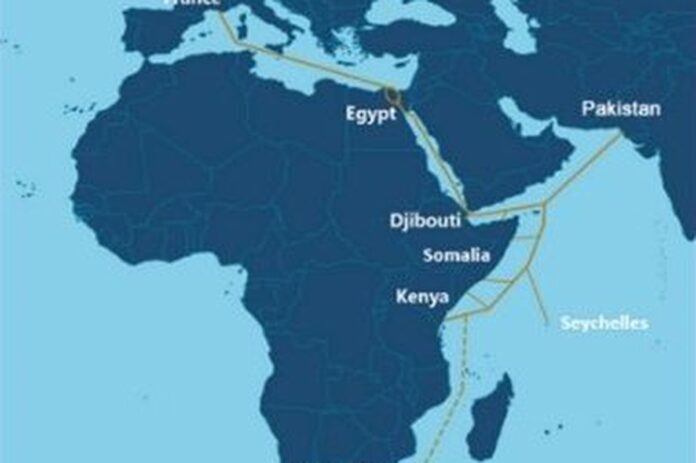Link up with Asia and Europe fuels Africa’s fastest growing economy
Thirteen years after Kenya welcomed its first ever fibre optic cable, the country has now unveiled a sixth submarine internet cable, reports The East African. The recent launch of the Pakistan and East Africa Connecting Europe (Peace) cable at the end of March came after a boom in data usage when the country’s internet economy was boosted by the Covid-19 pandemic.
The €361 million cable connects Africa to France and Pakistan through the Europe-Asia route, directly linking to Asia which could cut the comms delays between Africa and Asia.
The launch is a partnership between Peace and Kenya’s mobile operator Telkom, which claims to be the most affordable mobile operator in the East African nation. Kenya boasts one of the fastest growing economies on the continent but also the most expensive mobile data in East Africa, according to the GSM’s global Mobile Data Index.
The 15,000 kilometre cable is expected to create more flexible digital connection options, including speeds of 200 Gbps per single wavelength with a total capacity of 192 Terabits per second, as well as more stable and secure data access.
Speaking during the launch at Nyali, Mombasa, the government’s ICT and Youth Affairs Cabinet Secretary Joe Mucheru said Kenya was right inside the Fourth Industrial Revolution (4IR) where demand for fast internet is at an all-time high.
“Right now, you can enjoy 5G data speeds at Uhuru Gardens. This will revolutionise how Kenyans consume the internet. 5G smartphone penetration in Kenya is growing. More online business opportunities will be unlocked by this cable,” said Mucheru.
The growth in consumer demand for connectivity and data could create new markets for co-location data centres, content development networks and over-the-top service providers in the country, said Peace Cable’s chief operating officer, Sun Xiaohua. “Peace will bring more diversified digital connection options and provide high-speed, large-capacity and stable data access opportunities to Kenya,” said Xiaohua.
Telkom currently operates and maintains five of the six submarine cables that have landed in Kenya. “We’re upgrading and expanding our 4G capacity in the Coast region, before moving into other areas across the country. This Sh14 billion nationwide rollout is part of our long-term network expansion strategy,” said Telkom CEO Mugo Kibati.
Peace, a Hong Kong-based cable network founded in 2018, said its second phase will see the cable extend to Singapore and Southern Africa, boosting bandwidth and connectivity from its current African landing point in Mombasa, all the way to South Africa, consequently opening new markets in the Southern African Development Community (SADC).
When the East African Marine System (TEAMS) internet cable was first launched in June 2009 there was much talk of a digital transformation into a Silicon Savannah. Though those excitable predictions were premature the gradual laying of more cables has placed Kenya at the apex of internet penetration in Africa.
Since then, other internet cables landing in Mombasa have been the Eastern Africa Submarine Cable System (EASSy), the Lower Indian Ocean Network (LION), Seacom and the Djibouti Africa Regional Express 1 (DARE1), carrying data at speeds of 5.2 Tbps, 12.3 Tbps, 18.6 Tbps, 12 Tbps and 36 Tbps respectively.
Kenya Power also uses internet cables to manage the national electricity grid and leases the excess capacity to Safaricom, Airtel, Liquid Telecom and Jamii Telecommunications. Since launch in 2010, Kenya Power has cumulatively earned Sh3.02 billion (£€237 million) from the fibre leasing business, in its 4,000 kilometre long cables.
The International Finance Corporation (IFC) estimates a total of 1.1 million kilometers of fibre cables have been laid in Africa with 50 per cent of them being deployed by mobile operators. About 40 per cent of all 450,000 kilometers of fibre optic cable in Africa, is owned publicly by government networks, state-owned enterprises and utilities, according to IFC.


